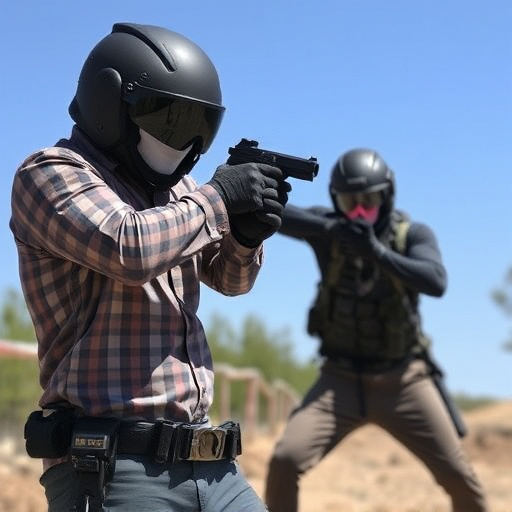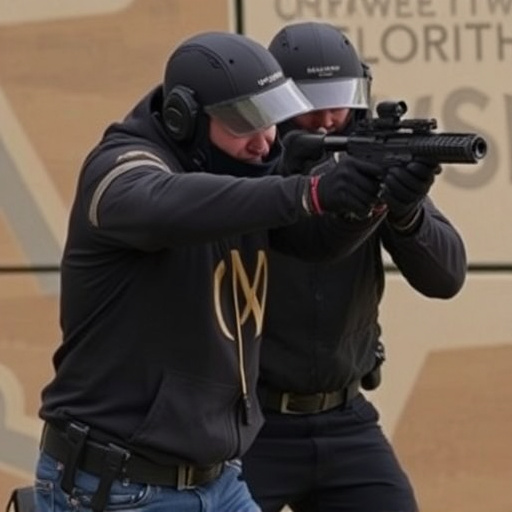Stun guns, despite their non-lethal intent, deliver electrical pulses (5000-15000 volts) that can cause diverse neurological side effects ranging from memory loss to muscle contractions. Understanding these effects and the voltage range is vital for safe handling and responsible use. Users must prioritize proper training, aim for non-lethal outcomes, and familiarize themselves with local laws governing stun gun usage to mitigate risks and legal repercussions.
“In the realm of personal safety, stun guns have emerged as a controversial yet potent tool. This article delves into the intricate world of stun gun functionality and its impact on the human body, specifically exploring the neurological side effects associated with different voltage ranges. We’ll guide you through safety specifications crucial for users, best practices to mitigate risks, and legal considerations surrounding stun gun voltage limits. Understanding these aspects is essential for those considering self-defense options.”
- Understanding Stun Gun Functionality and its Impact on the Body
- Neurological Effects: A Closer Look at Stun Gun Voltage Range
- Safety Specifications: What Users Need to Know Before Deployment
- Mitigating Risks: Best Practices for Safe Stun Gun Usage
- Legal Considerations and Regulations Around Stun Gun Voltage Limits
Understanding Stun Gun Functionality and its Impact on the Body

Stun guns operate by delivering a high-voltage, low-amperage electrical pulse to the body, temporarily incapacitating the target. This pulse disrupts the normal electrical activity in the brain and nervous system, causing muscular contractions, disorientation, and loss of balance. The impact is designed to be non-lethal but can still result in significant neurological side effects, such as temporary memory loss, headaches, and even long-term cognitive damage in repeated or prolonged exposure.
Understanding how stun guns function is crucial when considering their safety specs. The voltage range typically varies from 5,000 to 15,000 volts, depending on the model. This range is intended to ensure effectiveness against a wide array of threats while minimizing risk to users and bystanders. However, it’s important to remember that even within this range, higher voltages can lead to more severe neurological impacts, emphasizing the need for responsible use and proper training in handling these devices.
Neurological Effects: A Closer Look at Stun Gun Voltage Range

Stun guns, while designed for self-defense purposes, operate by delivering a powerful electrical shock to temporarily incapacitate a target. The voltage range of these devices plays a crucial role in understanding their neurological effects on the human body. Higher voltages can lead to intense neuromuscular disruption, causing muscles to contract uncontrollably and leading to temporary paralysis. However, it’s essential to note that stun gun neurological side effects are not always straightforward.
The electrical current disrupts the normal functioning of the nervous system, specifically affecting nerve signals and muscle control. This disruption can result in various physical reactions, from severe pain and spasms to disorientation and even respiratory distress. However, lower voltage settings may only induce a temporary numb sensation or slight muscle twitches, without causing significant harm. As such, understanding the stun gun’s voltage range and its corresponding effects is paramount for users to make informed decisions regarding their safety and the potential risks involved in using such devices.
Safety Specifications: What Users Need to Know Before Deployment

Before deploying a stun gun, it’s crucial for users to understand the safety specifications designed to mitigate potential risks. While stun guns are powerful tools for self-defense, their electrical current can have significant neurological side effects if not used properly. Users must familiarize themselves with the device’s voltage range and how it interacts with the human body.
Knowing the stun gun’s operating voltage is essential—it determines the level of force applied during activation. Higher voltages can cause more intense physiological responses, including muscle contractions, disorientation, and in some cases, temporary loss of consciousness. These side effects are designed to immobilize an assailant temporarily, allowing users to escape or summon help. However, it’s critical to deploy stun guns responsibly, aiming for non-lethal outcomes while still ensuring personal safety.
Mitigating Risks: Best Practices for Safe Stun Gun Usage

When using a stun gun, it’s paramount to understand that while it’s designed to incapacitate, it can also have neurological side effects. The voltage range of stun guns varies, but even lower-end models can cause significant discomfort and temporary paralysis. To mitigate risks, users must adhere to best practices. This includes ensuring proper training in the use of the device, understanding its limitations, and always aiming for non-lethal zones like legs or arms, avoiding sensitive areas like the head or neck.
Additionally, regular maintenance and inspection of the stun gun are crucial. Keeping the device clean and functional reduces the chance of unexpected malfunctions that could lead to unintended injuries. Users should also be aware of local laws and regulations regarding stun guns, as possession and use restrictions vary widely. Following these practices can help ensure safe usage while maximizing the effectiveness of the stun gun in emergency situations.
Legal Considerations and Regulations Around Stun Gun Voltage Limits

The legal landscape surrounding stun guns varies significantly across jurisdictions, reflecting a delicate balance between personal safety and public safety concerns. Regulations often dictate specific voltage ranges deemed acceptable for stun guns, with an eye towards minimizing potential harm while allowing for effective use in self-defense situations. Exceeding these limits can have severe legal repercussions, as high voltage settings may be considered excessive force or even cause neurological side effects.
Many countries and states have established guidelines that limit the maximum voltage a stun gun can emit to prevent significant health risks. These regulations not only consider the potential for physical harm but also the psychological impact on users and bystanders. Understanding and adhering to these legal considerations are paramount for anyone considering carrying or using a stun gun, as violations can lead to criminal charges and civil liabilities, in addition to the risk of causing unintentional neurological damage.
Stun guns, while designed for personal safety, come with a range of voltage options and associated neurological side effects that users should be aware of. Understanding the safety specifications and best practices outlined in this article is crucial to mitigating risks effectively. Remember that responsible use, within legal limits, can ensure stun guns serve as reliable tools for self-defense without causing undue harm. By staying informed about stun gun voltage ranges and their neurological impact, individuals can make informed decisions to protect themselves and others.
